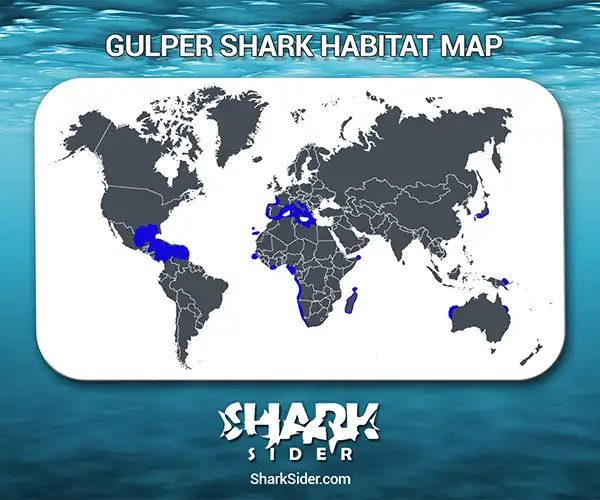Gulper sharks are a rare species of dogfish living in the ocean’s depths.
Gulper Shark Scientific Classification |
|
| Kingdom | Animalia |
| Phylum | Chordata |
| Class | Chondrichthyes |
| Order | Squaliformes |
| Family | Centrophoridae |
| Genus | Centrophorus |
| Scientific Name | C. granulosus |
Description
Gulper sharks are 3 ft long, with long slender bodies. These sharks have a long snout and a pair of large greenish eyes. They have two spiny dorsal fins, with the second being smaller than the first. Inside the shark’s mouth, one can see a set of 33-40 blade-like teeth on the upper jaw and 30 rows of teeth with serrated edges on the lower jaw.
These sharks are grayish-brown, being lighter in coloration when seen from below.
Where do they live
Map Of The Gulper Shark’s Habitat

The gulper sharks have been spotted throughout the oceans but only in a few specific areas. These include the Eastern Atlantic, ranging from France to South Africa, encompassing the Mediterranean Sea and the western and central Pacific, including Australia, Japan, Papua New Guinea, and the northern Gulf of Mexico. In the Indian Ocean, the gulper sharks live in the Aldabra Islands, Mozambique, South Africa, and Western Australia.
They generally live at depths between 328-3937 ft, around the outer continental shelves and upper slopes, close to the ocean floor.
Behavior
Hunting
While the shark’s diet remains unconfirmed, researchers assume they feed on lanternsharks. Other animals they feed on include bony fishes, cephalopods, and crustaceans.
Reproductive
They are ovoviviparous, giving live birth after a long gestation period of around two years. Initially, the pups are 1 – 1.4 ft long at birth and reach sexual maturity when the males are 7 to 8 years old, or the females are 12 to 16 years old. Due to their low reproductive rate, a female shark will give birth to 2 – 10 pups throughout her lifetime.
The sharks are long-lived, living around 54-70 years.
Adaptations
Their large eyes are assumed to help these sharks see in murky waters.
Interactions with humans
Humans only come into contact with gulper sharks during deep sea fishing. The shark possesses some value due to the oil produced by its liver but is mostly caught as a bycatch. While being caught as bycatch most of the time doesn’t severely deplete the populations of many marine species, the unpredictable nature of deep sea fishing combined with a low reproductive rate has pushed the overall population of this shark into a steep decline even dropping by 80% in certain areas.
As a result of heavy overfishing, the IUCN currently classifies the gulper shark as “Endangered” or “EN”. To prevent the population decline of deep-sea species like it, in 2005, the General Fisheries Commission for the Mediterranean (GFCM) banned deep sea fishing beyond 1000m. It is an insufficient effort – as several species, including the gulper shark, reside at depths of 300-400m. The United States initiated a more effective measure in 2010 – the Shark Conservation Act – which prevents shark fins from being removed from any bycatch in U.S. waters.
